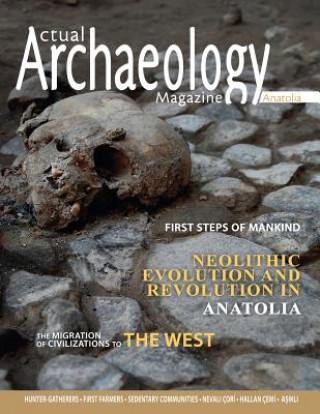
Kód: 12860429
Actual Archaeology
Autor Ayse Tatar, Murat Nagis
The Paleolithic Period, known to the public as "Old Stone Age", was a long period of time when mankind lived as mobile hunter-gatherers for almost two million years. They were living like other beings do in nature without produci ... celý popis
- Jazyk:
 Angličtina
Angličtina - Vazba: Brožovaná
- Počet stran: 100
Nakladatelství: Iboo, 2016
- Více informací o knize

Mohlo by se vám také líbit
-

Persistence of Modernism
1457 Kč -

Interchange Level 1A Workbook
644 Kč -

Race Distinctions in American Law.
854 Kč -

Ride: Competing for the Cup
697 Kč -

Intersektionalität und Narratologie
723 Kč -

Handbuch Drogen in sozial- und kulturwissenschaftlicher Perspektive
2478 Kč -

La Hija del de los Mares = The Sea King's Daughter
525 Kč
Informovat o naskladnění knihy
Zadejte do formuláře e-mailovou adresu a jakmile knihu naskladníme, zašleme vám o tom zprávu. Pohlídáme vše za vás.
Více informací o knize Actual Archaeology
 Anotace knihy
Anotace knihy
The Paleolithic Period, known to the public as "Old Stone Age", was a long period of time when mankind lived as mobile hunter-gatherers for almost two million years. They were living like other beings do in nature without producing, but instead only with using, viewing and transferring the opportunities that the nature offered them. During this long period of time, mankind's knowledge about nature increased and mankind learned how to manage nature. At the end of the Last Ice Age, almost 12 millennia ago, the climate began to get warm in Mesopotamia in the region between the Tigris and the Euphrates Rivers and the region was filled with a great variety of animals, plants and dried fruits. After the Paleolithic Period, the Neolithic Period, also called the "New Stone Age" began, when the hunter-gatherers who knew plants in nature well decided to produce their own plants and settled down. After all, the need for more food due to the increasing population caused social and technological changes to occur in the processes of food cultivation and domestication of wild animals. This breakthrough, which was the result of mankind's cultural development and the success of men against nature is called the "Neolithic Revolution". In this process, the seeds of civilizations were planted.The Paleolithic Period, known to the public as "Old Stone Age", was a long period of time when mankind lived as mobile hunter-gatherers for almost two million years. They were living like other beings do in nature without producing, but instead only with using, viewing and transferring the opportunities that the nature offered them. During this long period of time, mankind's knowledge about nature increased and mankind learned how to manage nature. At the end of the Last Ice Age, almost 12 millennia ago, the climate began to get warm in Mesopotamia in the region between the Tigris and the Euphrates Rivers and the region was filled with a great variety of animals, plants and dried fruits. After the Paleolithic Period, the Neolithic Period, also called the "New Stone Age" began, when the hunter-gatherers who knew plants in nature well decided to produce their own plants and settled down. After all, the need for more food due to the increasing population caused social and technological changes to occur in the processes of food cultivation and domestication of wild animals. This breakthrough, which was the result of mankind's cultural development and the success of men against nature is called the "Neolithic Revolution". In this process, the seeds of civilizations were planted.
 Parametry knihy
Parametry knihy
- Plný název: Actual Archaeology
- Podnázev: First Steps of Mankind
- Autor: Ayse Tatar, Murat Nagis
- Jazyk:
 Angličtina
Angličtina - Vazba: Brožovaná
- Počet stran: 100
- EAN: 9786056660764
- ISBN: 6056660761
- ID: 12860429
- Nakladatelství: Iboo
- Hmotnost: 254 g
- Rozměry: 279 × 216 × 5 mm
- Datum vydání: 31. May 2016
Oblíbené z jiného soudku
-

Dune
216 Kč -

Haunting Adeline
621 Kč -

Berserk Deluxe Volume 2
1092 Kč -

White Nights
89 Kč -

Powerless
268 Kč -

Atomic Habits
330 Kč -

Dune Messiah
228 Kč -

Berserk Deluxe Volume 3
1142 Kč -

One Day
221 Kč -

Berserk Deluxe Volume 1
1115 Kč -

Iron Flame
368 Kč -

Surrounded by Idiots
213 Kč -

Harry Potter and the Prisoner of Azkaban (Minalima Edition)
993 Kč -

Gravity Falls Journal 3
443 Kč -

Heaven Official's Blessing: Tian Guan Ci Fu (Novel) Vol. 1
420 Kč -

The Creative Act
568 Kč -

Dune
276 Kč -

Hunting Adeline
624 Kč -

A Little Life
290 Kč -

Children of Dune
230 Kč -

Heaven Official's Blessing: Tian Guan Ci Fu (Novel) Vol. 2
427 Kč -

Bungo Stray Dogs, Vol. 8 (light novel)
383 Kč -

Percy Jackson and the Olympians 5 Book Paperback Boxed Set
944 Kč -

Solo Leveling, Vol. 1
440 Kč -

The Prisoner's Throne
247 Kč -

Court of Thorns and Roses
268 Kč -

Cry Baby Coloring Book
276 Kč -

Fourth Wing
407 Kč -

Icebreaker
199 Kč -

Berserk Deluxe Volume 6
1089 Kč -

Avatar, the Last Airbender: The Kyoshi Novels (Box Set)
986 Kč -

The 48 Laws of Power
601 Kč -

House of Leaves
611 Kč -

Twisted Lies
213 Kč -

Dune Messiah
272 Kč -

No Longer Human
359 Kč -

48 Laws Of Power
331 Kč -

Twisted Games
213 Kč -

Caraval Paperback Boxed Set
902 Kč -

Solo Leveling, Vol. 2
468 Kč -

Open Circuits
907 Kč -

Berserk Deluxe Volume 5
1119 Kč -

Heaven Official's Blessing: Tian Guan Ci Fu (Novel) Vol. 3
436 Kč -

Berserk Deluxe Volume 4
1125 Kč -

Court of Mist and Fury
206 Kč -

SOLO LEVELING V08
436 Kč -

English File Upper Intermediate Multipack A (4th)
531 Kč -

CHAINSAW MAN V14
254 Kč -

Before the Coffee Gets Cold
184 Kč
Osobní odběr Praha, Brno a 12903 dalších
Copyright ©2008-24 nejlevnejsi-knihy.cz Všechna práva vyhrazenaSoukromíCookies



 Vrácení do měsíce
Vrácení do měsíce 571 999 099 (8-15.30h)
571 999 099 (8-15.30h)